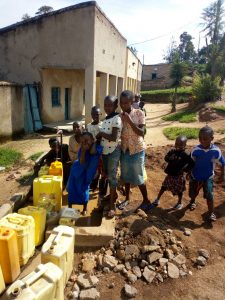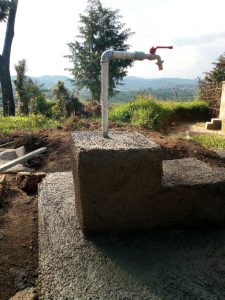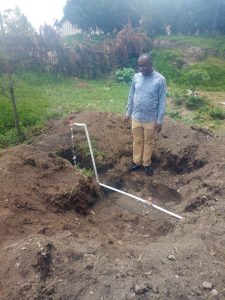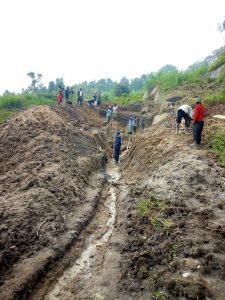This project is made possible through the partnership of WATER CHARITY and the NATIONAL PEACE CORPS ASSOCIATION. ![]()
This project has been completed. To read about the conclusion, CLICK HERE.
Location
This project summary has been redacted for security reasons to omit the specific project location.
Xxxxxxxx Village, Nkomero Cell, Mukingo Sector, Nyanza District, Southern Province, Rwanda
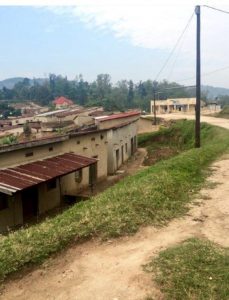 Community Description
Community Description
Between 1996 and 2013, Action Aid – a program of USAID, provided water access to Nkomero Cell from Nyakokoma mountain via pipes, tanks, and taps, a distance of approximately 2 kilometers.
In 2013, a new hospital was built a few kilometers away and the water was rerouted to the new hospital, depleting water access from Nkomero cell. As a result, the existing infrastructure has fallen into disrepair and is going unused.
This project will focus on the two villages where the pipes directly run through – Yyyyyyy and Xxxxxxxx. Xxxxxxxx village is located at the center of Nkomero cell.
In total Nkomero cell contains 10 villages. In the central village Xxxxxxxx, there are many facilities central to the cell, Including Nkomero Primary School (1268 students), Nkomero Secondary School (512 students), a poste de sante (small health clinic), police station, and cell office.
Problem Addressed
All the facilities have tanks that fill up during the rainy season, but during the dry season water access becomes a major issue. Once the water from the rainy season is depleted, the police station, school, and health center, along with all the community members must rely on fetching water.
The distance to the closest water source, streams that run at the bottom of the valley, imposes a significant burden on women and girls who are the primary water carriers for their families. The cost of hiring someone is 3,000 francs a month for one jerry can a day but most families use up to 3 jerry cans a day, making this not feasible. (A cow alone drinks one jerry can a day.)
During the dry season, students are often required to fetch water during school so that the school kitchen will have enough water to cook the daily meal. This job is divided amongst classes so as to minimize time out of the classroom but the headteacher estimated that students are losing about an hour a week from fetching water.
Students fetch water during the day for the cooks to cook and clean the school with only. There is no water for the students to drink regularly during the day nor to use to wash their hands. Hygiene and water are directly linked. Fetching water is also incredibly time-consuming. Both villages are densely populated and this causes high congestion even at the existing places where water is accessed.
Project Description
This project is to provide a water system to serve the villages of Xxxxxxxx and Yyyyyyy.
Nkomero cell, located in the southern region of Rwanda, contains 10 villages. The project will target two villages with existing piping and tanks. The village of Xxxxxxxx is home to approximately 667 people and Yyyyyyy, the neighboring village, is home to approximately 867 people who do not have accessible, clean water.
These two villages were chosen as a priority because the first village, Yyyyyyy is where the water source is located, and Xxxxxxxx is located at the center of the cell containing facilities used by all other villages including a small health center, two schools, and a police station.
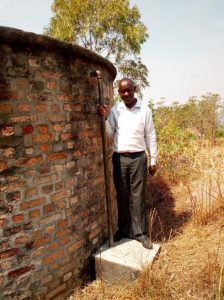 In addition, there is an existing main water line from the Nyakokoma mountain through the villages to E.S. Nkomero Secondary School. The project will build a secure water source in Yyyyyyy Mountain, 2 kilometers from Nkomero center.
In addition, there is an existing main water line from the Nyakokoma mountain through the villages to E.S. Nkomero Secondary School. The project will build a secure water source in Yyyyyyy Mountain, 2 kilometers from Nkomero center.
The construction of the water source uses local techniques to first dig a trench then install a plastic sheet to collect water from the mountain. The filtration process consists of using local materials such as small rocks, charcoal, and sand. The water will be collected at the source and confined in a nearby catchment which will be attached to the repaired main pipeline.
Beyond Yyyyyyy and Xxxxxxxx village, the project will have even farther-reaching effects because students come from all over Nkomero cell to attend school in Xxxxxxxx at E.S. Nkomero Primary and Secondary School. Often in the rainy season students living in various villages outside of Xxxxxxxx will bring a container to school and fill up their small container at the end of the day, if there is water in the rain tank, to take back to their families.
When there is more consistent water access at the school students who live in communities without water access can continue to support their families. While this project focuses on two villages, it provides support for the entire cell.
The project will be completed over the course of 3 months. The implementation of the water infrastructure is below.
Month 1: Site installation – engineer planning, purchasing and delivery of materials; Labor- excavation and backfilling of 1.5km, laying of pipes
Month 2: Labor- excavation and backfilling of 1.5km, laying of pipes,
Month 3: Labor- excavation and backfilling of 1.5km, laying of pipes, construction of manhole and tap, site cleaning
There are a number of expected and potential challenges. A majority of labor will be completed during umuganda. This will occur about twice a week. Unforeseeable circumstances like rain or low attendance may occur. Supervision and project management on these days will be vital.
The project will also involve coordination between a number of people including the PCV, engineer/technician, cell officials, village officials, and the Head Teacher.
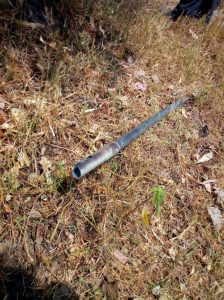 Project Impact
Project Impact
1,534 people will benefit from the project.
Peace Corps Volunteer Directing Project
L. Adelstein
Monitoring and Maintenance
The community leaders have come together and decided that guards will be secured in each village. These guards will be villagers but they will change every so often.
In addition, there will be talks lead by local leaders to reinforce the importance of water access within the community and the roles that each village can play in making this a safe and healthy environment for everyone. A committee will also be elected by the community to protect and preserve the community project.
Comments
Water access in the village affects every aspect of life. It means healthier villagers, cleaner homes, and less time and energy spent on gaining access to an essential resource. This project will also profoundly support the efforts of the local school and poste de santé.
Water is imperative for hygiene at the poste de santé which services many villagers who cannot get to the hospital or larger health center. The poste de santé also sets an example for hygiene and water hydration.
The school will also greatly benefit from water access – students will no longer have to miss school to fetch water. The water is used to make lunch. Greater access means that students can drink water during the day. They can wash their hands. And clean the classrooms.
The headteacher of E.S. Nkomero also pointed out the importance of the school garden. Currently, the land by the school is going unused because there is not enough water but when there is enough water the students and school staff can work together to grow many different types of crops. This can assist with school lunches and help to decrease the price of lunch, which at 4,000 francs a month, is a financial burden on many families.
Project Funding
This project has been funded by an anonymous donor. Additional donations using the Donate button below will be used for our next project in Rwanda.
 Conclusion of Nkomero Cell Water Project – Rwanda
Conclusion of Nkomero Cell Water Project – Rwanda
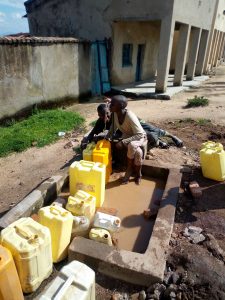 This project has been completed under the direction of Peace Corps Volunteer Lillian Adelstein. To read about the start of the project, CLICK HERE.
This project has been completed under the direction of Peace Corps Volunteer Lillian Adelstein. To read about the start of the project, CLICK HERE.
The project was designed to build sanitation facilities at the Master Farm and Franco-Arab school as well as return latrines at the French school to working order.
Lillian reports:
The water project in Nkomero has been completed!
This project provides 1,534 people with water access though the installation of 7 taps located in 2 villages, a health center, police station, secondary school and primary school. Overall, the project repaired 7 tanks and 5 km of piping.
The project was divided into 2 main stages. The first stage took place between February 1st and February 23, 2018. This stage included building the water source in the mountain located 4 km from the school and connecting pipes from that water source to the first tank, located 2 km from the water source, between villages 1 and 2. The water reached the first tank on February 23rd, 2018.
The next stage of the project connected the middle water tank, between village 1 and 2, to the tap in village 2, and the other public facilities located in the village 2, which also acts as the center of the Cell (a collection of 10 villages). At this time the pipes passed through the village 1 but there was no tap installed there because we were uncertain whether the water pressure would be strong enough to reach the school and main public facilities. The goal at this time was to make sure water reached the main facilities and then to revisit the site at the village 1 to install a tap. As you might guess, this caused a lot of difficulty and stress at the time, but the issue was well managed by the local leaders of the village, Cell, and the head teacher of the secondary school.
The first tap installation was at the secondary school on March 27, 2018, followed by the primary school, health center, and police station. The final step of the project was the tap in the center of the cell and center of village 2 which was connected on March 30th, 2018.
After the final installation of the project was complete and water reached the main public facilities, a tap was constructed in village 1. In total the project repaired 7 tanks, installed 7 taps, repaired approximately 5 km worth of piping, servicing 1,534 people.
Labor of the project included both paid labor and community collaboration through Umuganda, national community work that occurs once a week at the village level and once a month at the Cell level.
Approximately 400 people in Nkomero participated in Umuganda to help with the project. Overall, John, an engineer based out of the southern region of Rwanda, led the project. Two lead technicians aided him.
In terms of local leadership, management, and sustainability, this will be carried out by local leaders including Janvier and Marie Claire, the leaders of the Cell, who oversee the management of all 10 villages, the headteachers of the secondary and primary schools, titular of the health center, chief police officer, and village chiefs in both the 1st and 2nd villages.
Currently the maintenance and any repair costs that may arise will be managed by a community fund, but on a district level, the government has partnered with a fund to repair and maintain all pipes and water systems in Nyanza district. This means that in the future if there are any issues, those issues can be submitted to this fund and repaired by engineers in the region.
Community Comments:
Comments from Headteacher of E.S. Nkomero school, Magnificat:
(paraphrased and changed for grammar and understanding purposes) This project has been very important. Water is incredibly important. It helps with hygiene at the school, cooking, and all around supports the education of the children. Before the project we needed to send students out to fetch water during the school day, for drinking, cooking, and cleaning. The impacts of the water project will be felt most strongly during the dry season when water becomes a big issue.As I mentioned, students before had to go to the valley during the school day to fetch water, where they would then have to wait and compete with locals who also needed water. Also, the water supports our school initiative to feed all the students, by supporting the growth of our school garden. Many students cannot pay for school lunches which puts a strain on the school but when we can cultivate our own garden, not only can we reduce the overall cost of feeding, but we can make lunches more nutritious by adding more vegetables. The project also helps to maintain the structure of the school and reduce repair costs, for example building new classrooms demands lots of water to construct bricks, now instead of having to fetch water from the valley we can use the water at school and decrease time spent on construction.
Arlette, Teacher of Religion, Economics & Geography at E.S. Nkomero:
Thank you, Water Charity, for the support that you have offered. It has helped many people and helped resolve many problems facing this community. Before, in this village there was no good water. This project will continue to help and fight to prevent illnesses that are caused by bad water. This water project has helped the community of Nkomero and will have lasting effects.Antoine, Local Business Owner:
This was a very good project that came at the right time. I have lived here since 2015 and since that time there has been no water in the village. Before the tap in the village center, people had to fetch water from the wetlands and valleys. This water was often contaminated but it was the only choice for people. In addition to the poor quality of water offered in the valley’s and wetlands, it took people a long time to travel there. Often this burden falls on children who are then late for school and end up getting punished. We appreciate the actions of this project and hope to protect and preserve it for many years to come.Janvier, Leader of Nkomero Cell:
The people are so happy. The water taps in the villages serve many people and make it easy for them to fetch good water. Even though the project is over, there is still a lot of work ahead. We have to manage the project well, making sure that the two villages trade off using their taps at certain times – Kabarima in the afternoon, Gitovu in the morning, especially during the dry season. The people are also talking about growing this project in the future, hopefully to bring water into peoples homes.
Please watch Video 1 and Video 2.
We extend our thanks to Lillian for completing this important project.
